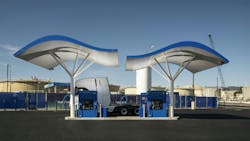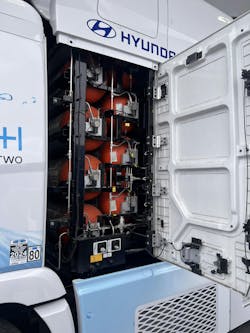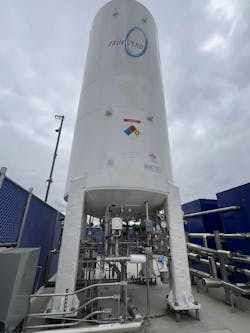A new kind of fueling system helps scale H2 infrastructure
Clean hydrogen has the potential to cut trucking’s carbon output. However, filling large H2 tanks for fuel cells and internal combustion engine trucks is complicated. FirstElement Fuel, which will open the nation’s first public hydrogen truck stop this month, has solved this fueling challenge with a cryopump.
“As we started rolling out a network of [light-duty] stations, we quickly learned that technology that was available out there was not commercially viable,” said Dr. Shane Stephens, FirstElement founder and chief development officer. “It couldn't scale, it couldn't meet the needs of the public, and it didn't have the reliability for the business model necessary to make it viable.”
Customers waiting to fill their hydrogen vehicles at FirstElement’s first-generation stations didn’t like the experience, Joel Ewanick, FirstElement’s executive chairman of its board of directors, explained. The fueling method to pump 3 to 4 kg of hydrogen for smaller, consumer vehicles took 30 to 40 minutes. Using that same fueling technology to fuel heavy-duty vehicles, which require about 60 kilograms of hydrogen for a complete fill, would prove excessively inefficient.
Overcoming this obstacle, FirstElement began using a hydrogen fueling method called cryopump. FirstElement has used cryopump technology at its light-duty stations for five years, establishing the company as the “technology leader in bringing hydrogen cryopumps into the commercial setting,” Stephens said.
What is cryopump technology?
Hydrogen refueling is more complex than gasoline and diesel refueling. This is because “hydrogen is stored on-site either in liquid form at minus 253 degrees Celsius [minus 423 degrees Fahrenheit] or as a gas in tanks with various pressure levels,” according to a Bosch Rexroth press release. This means that “hydrogen must be compressed in a controlled manner to between 700 and 900 bar,” about 10,000 to 13,000 psi, to refuel vehicles.
As hydrogen moves, it heats up. When filling a Class 8 vehicle’s large tank, it rapidly expands. To achieve a fast fill, hydrogen must be pre-cooled to prevent it from heating up to the point that it loses its energy, Stephens explained.
The cryopump FirstElement now uses solves this problem because it compresses hydrogen by 700 bar, leading to much quicker refuel times. It also maintains the sub-cooled temperature. In one step, a cryopump converts cold, liquid hydrogen into cold, compressed hydrogen and delivers it into the vehicle.
The cryopump also uses only about one-fifth of the energy that compressors need for an alternative method of hydrogen refueling. Further, the whole system takes up less space. A cryopump can deliver a higher capacity of hydrogen while taking up about 1/30th of the space needed for a compressor, Stephens explained.
Using cryopump technology, “we went from being able to [fill] 40 cars per day to being able to fill about 400 cars per day,” Stephens said. “[Cryopumps] got us to fast fills, simultaneous refueling, and higher volume overall. They also established a platform by which we could scale up to the needs required for heavy-duty trucking.”
The first FirstElement station equipped with cryopump technology came to California in 2019. Since then, FirstElement has deployed 20 light-duty vehicle stations with this technology, bringing FirstElement Fuel’s total station footprint to 41 locations with 92 fueling stations, supporting more than 16,000 fuel cell cars in California, Stephens said.
See also: Feds fueling $8B nationwide hydrogen hub investment
Breakdown of the new cryopump technology
Because hydrogen must be compressed in a controlled manner between 10,000 and 13,000 psi to refuel vehicles, hydrogen refueling infrastructure has yet to scale. Bosch Rexroth, in partnership with FirstElement Fuel, will soon change that.
The Bosch Rexroth uses servohydraulic drive technology with a variable hydrostatic transmission in the new cryopump, which enables a long service life. The Bosch cryopump also uses long-stroke, ATEX-certified drive cylinders for compressors that increase delivery rates due to end position-optimized control.
The Bosch Rexroth and FirstElement cryopump is electrohydraulically driven. With a connection rating of 280 kW, it compresses liquid hydrogen to 875 bar, or 12,690 psi, to directly refuel heavy-duty trucks. This new cryopump should refuel up to 100 kg of hydrogen within 10 minutes.
The new cryopump's servohydraulic pump control also reduces energy consumption by roughly 75%. The whole system also takes up less space; the compressor drive system requires less than 10 square feet of installation area.
Hydrogen refueling stations will begin receiving this new cryopump technology in 2025.
Advantages of the Bosch Rexroth and FirstElement Fuel cryopump
Cryopumps currently used in FirstElement’s True Zero stations—the company’s consumer-facing brand—can fuel Class 8 vehicles within 10 to 15 minutes. However, FirstElement wants to continue improving this fueling method and partnered with Bosch Rexroth to see it through.
“In partnership with Bosch, we’ve developed a high-volume, high-performance next-generation cryopump for truck stations,” Stephens said. “That's a major enabler for commercial vehicle refueling with hydrogen. That technology is critical because it can unlock scale volume and efficiency required for refueling of all hydrogen-powered vehicles—but especially vehicles with larger tanks, such as heavy-duty trucks.”
The Bosch and FirstElement Fuel partnership began a little more than a year ago, and Dave Hull, Bosch Rexroth’s regional VP, said this new cryopump could dramatically accelerate the adoption of hydrogen fuel in heavy-duty trucking.
“The vehicles, they're ready,” Hull told FleetOwner. “It's the cost of fueling and how to operate these fueling stations that's missing... There's some excitement, there's a knowledge, there's a vision that this [new cryopump] could be the catalyst that addresses this adoption.”
See also: Bosch doubles down on hydrogen as key to trucking’s sustainable future
The new cryopump is the highest capacity cryopump in the world by more than double. It’s capable of pumping 2,400 kg of hydrogen per hour with continuous back-to-back refueling across four 600 kg-per-hour pumps. It should refuel up to 100 kg of hydrogen within 10 minutes. This means heavy-duty, Class 8 hydrogen fuel cell trucks can fill from empty to full in an amount of time comparable to fueling a diesel-powered Class 8 truck.
While the FirstElement Fuel truck stop opening in May isn’t yet equipped with the new cyropump, FirstElement and Bosch expect the station to receive it sometime next year. Until then, the new cryopump is currently in testing at FirstElement’s proving grounds in Livermore, California.
About the Author
Jade Brasher
Senior Editor Jade Brasher has covered vocational trucking and fleets since 2018. A graduate of The University of Alabama with a degree in journalism, Jade enjoys telling stories about the people behind the wheel and the intricate processes of the ever-evolving trucking industry.



